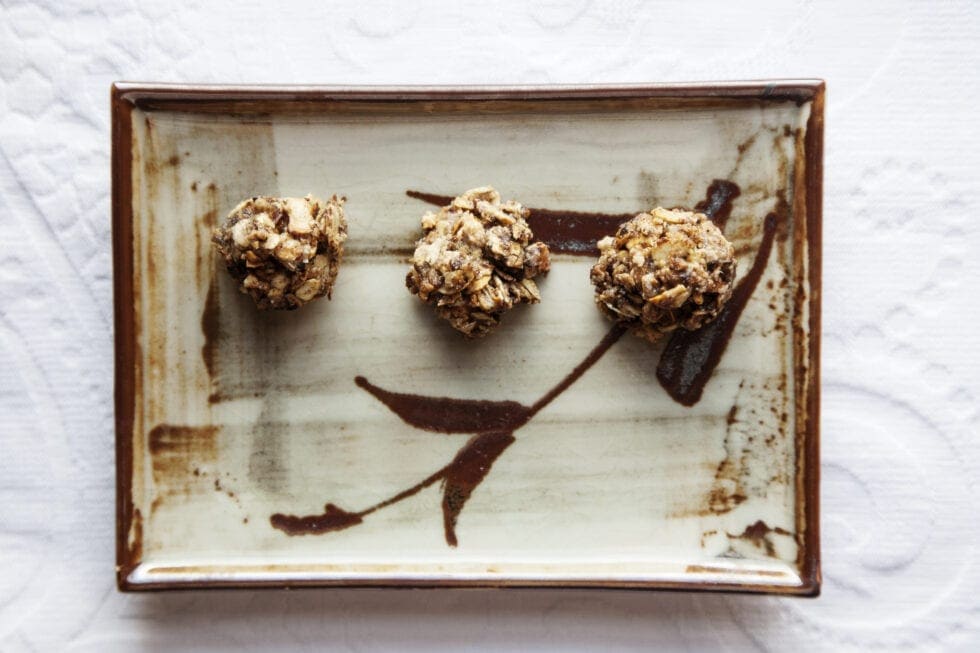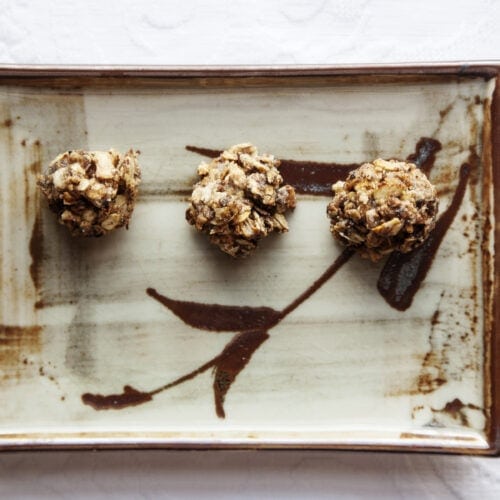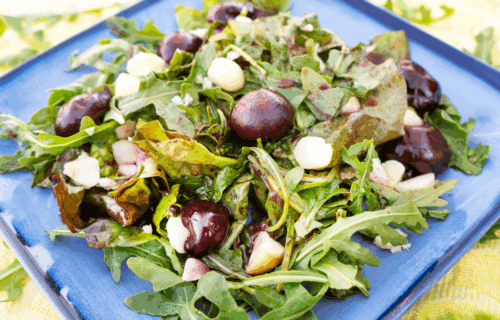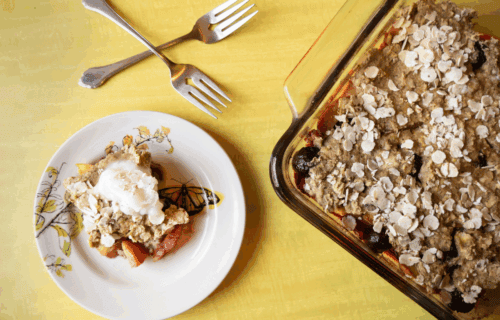
Low Histamine Pecan Clusters Recipe (also Low Lectin, Medium Oxalate)
I love a tasty low histamine treat that makes me feel like I have no food cares in the world!
It’s such a good feeling to indulge in something so delicious that my husband (who doesn’t have food restrictions) would want some!
It’s even better when those treats come with some great health benefits.
I’ve got a recipe for you this week that checks all those boxes. It’s for Pecan Clusters.
This recipe was originally shared by a member of our Mast Cell 360 community, Susan. Thank you, Susan!
Pecans happen to be one of my favorite foods to use in recipes. They are low histamine and low lectin. They are also medium oxalate at ¼ cup or less per serving.
Pecans are a go-to ingredient for me because they work well in everything from baked goods to savory dishes.
These pecan clusters are semi-sweet small bites. And you’ll probably want more than one! The tiger nuts give these clusters crunch, and the pecan butter brings a touch of creamy richness.
But unlike other pecan cluster recipes you might find online, this recipe doesn’t have sugar or high histamine ingredients. It’s low lectin and medium oxalate, too. You won’t miss the caramel and chocolate at all.
These pecan clusters have a satisfying and chewy sweetness that will satisfy a snack attack or sweet tooth! You might want to make multiple batches.
I did make one modification to Susan’s original recipe so that even more people could enjoy the recipe. I’ve swapped oats for tiger nuts. Keep reading to find out why this little change may make these treats easier on your system.
Oxalates, Lectins, and Histamine – OH MY!
The pecan clusters recipe Susan shared originally called for oats. Oats are certainly fine for you if your only concern is choosing low histamine foods.
But oats are high in lectins and oxalates.
Now, why does this matter?
If you have Mast Cell Activation Syndrome, your mast cell receptors are over-responsive.
So, minimizing mast cell triggers can help with the number of reactions you experience…especially if you are still very sensitive.
That’s why you may need to be careful with certain kinds of foods. For example, foods that are high lectins and oxalates can trigger mast cells.
But in time with addressing root triggers, it’s often possible to get some of these foods back!
I used to be able to only eat 10 foods. My diet was very restricted (which I don’t recommend at all). But now, I can eat a very wide variety of foods!
I’ve been able to add back medium level oxalate foods for some time now. I can even eat some lectins from time to time, too, without having a reaction.
I’m still mindful of the choices I make.
But I’ll never forget what it was like to react to so many foods. That’s why I want to give you recipes with options if you still have food restrictions and are addressing mast cell triggers, like oxalates or lectins.
So, this is the reason why I’ve swapped high lectin, high oxalate oats for low lectin, low oxalate tiger nuts in this recipe.
And I work to include nutrient-dense, mast cell supporting foods in every recipe we put out. Our mast cells and rest of our body need as many nutrients as we can get when we’re recovering!
Pecans and tiger nuts give this tasty recipe some healthy bonuses. I’ll share those with you in just a minute. But first, do you know tiger nuts aren’t really nuts?
Pecan Clusters with Tiger Nuts
This recipe for pecan clusters is super simple with just a few ingredients. You’ve got to love that! The two major ingredients are tiger nuts and pecans.
Pecans are seeds from the pecan tree. These are the edible nuts you are likely already familiar with.
Fun Fact: Pecan trees are a species of hickory nut tree.
But have you tried tiger nuts yet? If so, what did you use them in? (I’d really like to know!)
Did you know that even though they are called nuts, tiger nuts aren’t really nuts?
They are underground tubers like potatoes. You might also hear tiger nuts referred to as “earth almonds”.
They are called tiger nuts because when they come out of the ground, they have a striped pattern. You won’t be using tiger nuts straight from the ground, like a potato, though. You’ll be using them like you would other nuts.
The whole tiger nuts are a bit hard to chew. I highly recommend getting them pre-sliced.
Tiger nuts are the secret ingredient in my flaxseed crackers recipe.
Check out some of the health benefits you’ll find in this recipe next!
Benefits of Pecans and Tiger Nuts
Pecans and tiger nuts give this tasty recipe some healthy bonuses that can help support your mast cells:
- Fiber
- Magnesium
- Protein
1. Fiber
Fiber is probably most well-known for its role in aiding digestion and motility. Good digestion can help with Mast Cell Activation, by the way!
That’s right!
First, fiber can help prevent constipation and improve motility in both loose stools and constipation.
Fiber is also very important to feed the healthy bacteria in your gut. These healthy bacteria have been shown to help:
- Reduce mast cell activation
- Lower histamine
- Reduce oxalates in the gut
- Provide important nutrients for your body
Plus, these gut bacteria make 90% of your serotonin as well as other neurotransmitters that are key for calming and balancing your nervous system. These include GABA, dopamine, and nor-epinephrine.
There is a big link between the gut-nervous system axis and your immune system. And particularly a calm, balanced nervous system and calm mast cells.
In fact, keeping your gut healthy can help keep the mast cell responses down through a healthy microbiome.
There are even more connections…
Studies show fiber can boost the immune system and help reduce inflammation. Reducing inflammation is also so important with Histamine Intolerance and Mast Cell Activation Syndrome.
That’s because when mast cells are triggered, they can release histamine. Histamine is inflammatory. If you have a lot of inflammation, supporting yourself with nutrient-dense, anti-inflammatory foods can be very helpful.
Pecans and tiger nuts also offer magnesium. Here’s how that can help you if you have Mast Cell Activation Syndrome or Histamine Intolerance.
2. Magnesium
Magnesium is one of the most important nutrients in your body. Your body uses magnesium in over 300 different processes!
Specific to your mast cells and histamine levels, magnesium helps:
- Increase DAO to break down histamine
- Support mast cell stabilizing
- Reduce histamine production
Your body needs magnesium to make diamine oxidase (DAO). This is an enzyme your body should make to break down histamine.
If your body isn’t making enough DAO to keep up with your histamine load, that’s where you’ll get histamine intolerance.
Mast cells release histamine, but histamine also triggers mast cells. It’s one of those cycles that reminds me of that picture of the snake biting its own tail. Mast cells release histamine –> histamine triggers mast cells –> mast cells release more histamine and on and on.
Another enzyme that gets rid of histamine is HNMT. It is dependent on your methylation cycle, which also needs magnesium.
Magnesium even helps your body make less histamine. Studies show it helps reduce production of histamine in mast cells by lowering HDC (histamine decarboxylase) activity.
So, you want to do what you can to support more DAO production and less histamine production. Getting enough magnesium can help with this.
Before we get to the recipe, I do want to tell you about one more important health benefit from this recipe…Protein.
3. Protein
Tiger nuts have some protein, but pecans are a powerhouse of plant-based protein.
Protein is essential to so many of the body’s functions.
Protein is used in your body for:
- digestion
- carrying oxygen to your cells
- energy
- building and repairing tissue
- immune health
- hormone production
- and much more.
And of course, your mast cells are part of your immune system, too. So, immune support can help with mast cell support!
Overall, you can see just how many ways protein can support your health!
Doesn’t all that healthy goodness just make you want to eat some of these treats right now?
The good news is that this pecan clusters recipe only takes 15 minutes of active prep time to make. They then just need to chill for an hour after that.
That means that in just over an hour, you’ll be ready to eat them!
Tip: Be sure to get pesticide-free pecans! Pecans can be high in pesticide residues, which are known mast cell triggers.
You definitely don’t want toxic pesticide residue triggering your mast cells.
Recipe provided to us by Susan V.

Low Histamine Pecan Clusters Recipe
Equipment
Ingredients
- 2 cups Sliced Tiger Nuts
- 1½ cups Chopped Pecans
- 3 tablespoons Dr. Bronner's Coconut Oil melted
- ¼ teaspoon Redmond Real Salt
- ¼ teaspoon Smart Monk 100% Pure Monk Fruit Powder
Instructions
- Toast tiger nuts in a skillet on the stove for 3-5 minutes, stirring continuously. You don’t need to add any oil. (Do this on medium-low heat.) They can burn easily, so keep a close watch.
- When the tiger nuts start to turn lightly golden, transfer them to a medium mixing bowl. Set aside.
- Make pecan butter by putting pecans in the food processor. Pulse until you get a thick paste.
- Melt the coconut oil. Then add the melted coconut oil, salt, and monk fruit powder to the pecan butter. Pulse until ingredients are mixed. Scrape down the sides several times during this process to get a smooth, even blend. (You can also use a blender if you don’t have a food processor.)
- Transfer the pecan butter/coconut oil mixture into the bowl with the tiger nuts and stir until tiger nuts are well coated.
- For best results, use a mini scoop to create the clusters. Pack the mixture tightly into the scoop. Then release the contents of the scoop onto a cookie sheet or other flat pan that will fit in your freezer. (Pyrex baking dishes with unbleached parchment paper also work really well.) If your mixture is too crumbly and doesn't hold together, you can mix in more coconut oil. Just add extra in very slowly so it doesn't get too runny.
- OPTION: If you can't get the mixture to hold a ball shape, you can spread it out into a layer. When frozen, you can use a knife to break up the pieces into a pecan "bark." It tastes equally delicious.
- Put the tray of clusters into the freezer for about an hour. Gently remove the clusters and enjoy!
- Store leftovers in enclosed storage containers. Store in your freezer or refrigerator and eat cold.
Notes
Nutrition
More Low Histamine Dessert Recipes
- White Chocolate Cookie Dough – Low Lectin and Low Oxalate
- Macadamia Nut Butter – Low FODMAP, Low Lectin, and Low Oxalate
- Blueberry Cassava Flour Muffins – Low Lectin, Medium Oxalate, with Low Salicylate Options
- 6 Layer Cranberry Trifle – Low Lectin and Low Oxalate
- Baruka Nut Vanilla Mousse – Low FODMAP, Low Lectin, Medium Oxalate, with Low Salicylate Option
What other kinds of low histamine snacks or desserts like the pecan clusters would you be interested in seeing us make?
*Some links in this website are affiliate links, which means Mast Cell 360 may make a very small commission if you purchase through the link. It never costs you any more to purchase through the links, and we try to find the best deals we can. We only recommend products that we love and use personally or use in the Mast Cell 360 practice. Any commissions help support the newsletter, website, and ongoing research so Mast Cell 360 can continue to offer you free tips, recipes, and info. Thank you for your support!
References
Barbosa-Lorenzi, V., Buranello, P., Roque-Barreira, M., Jamur, M., Oliver, C., & Pereira-da-Silva, G. (2011, December 16). The lectin ArtinM binds to mast cells inducing cell activation and mediator release. ScienceDirect. https://www.sciencedirect.com/science/article/pii/S0006291X11020328?via%3Dihub
Jahnen-Dechent, W., & Ketteler, M. (2012). Magnesium basics. Clinical kidney journal, 5(Suppl 1), i3–i14. https://doi.org/10.1093/ndtplus/sfr163
Jing, S., Ouyang, W., Ren, Z., Xiang, H., & Ma, Z. (2013). The in vitro and in vivo antioxidant properties of Cyperus esculentus oil from Xinjiang, China. Journal of the science of food and agriculture, 93(6), 1505–1509. https://doi.org/10.1002/jsfa.5927
Liu, T. (2019, October 18). Evidence-Based Analysis of Neurotransmitter Modulation by Gut Microbio. SpringerLink. https://link.springer.com/chapter/10.1007/978-3-030-32962-4_22?error=cookies_not_supported&code=be19a860-1021-4e9b-a0e7-98a5bd24857c#citeas
Ma, Y., Hébert, J. R., Li, W., Bertone-Johnson, E. R., Olendzki, B., Pagoto, S. L., Tinker, L., Rosal, M. C., Ockene, I. S., Ockene, J. K., Griffith, J. A., & Liu, S. (2008). Association between dietary fiber and markers of systemic inflammation in the Women’s Health Initiative Observational Study. Nutrition (Burbank, Los Angeles County, Calif.), 24(10), 941–949. https://doi.org/10.1016/j.nut.2008.04.005
Mayo Clinic Staff. (2021, January 6). Dietary fiber: Essential for a healthy diet. Mayo Clinic. Retrieved January 21, 2022, from https://www.mayoclinic.org/healthy-lifestyle/nutrition-and-healthy-eating/in-depth/fiber/art-20043983?reDate=22012022
Moral-Anter, D., Campo-Sabariz, J., Ferrer, R., & Martín-Venegas, R. (2020). Cyperus esculentus L. Tubers (Tiger Nuts) Protect Epithelial Barrier Function in Caco-2 Cells Infected by Salmonella Enteritidis and Promote Lactobacillus plantarum Growth. Nutrients, 13(1), 71. https://doi.org/10.3390/nu13010071
Miyoshi, M., Ueno, M., Matsuo, M., Hamada, Y., Takahashi, M., Yamamoto, M., Yamamoto, I., Mikajiri, R., Tabuchi, S., Wakida, K., Yamanishi, M., Hirai, M., & Usami, M. (2017). Effect of dietary fatty acid and micronutrient intake/energy ratio on serum diamine oxidase activity in healthy women. Nutrition (Burbank, Los Angeles County, Calif.), 39-40, 67–70. https://doi.org/10.1016/j.nut.2017.03.004
Nishio, A., Ishiguro, S., Miyao, N. (1983, December 5). Toxicological and Pharmacological Studies on Magnesium Deficiency in Rats : Histamine-Metabolizing Enzymes in Some Tissues of Magnesium-Deficient Rats. The Japanese Society of Veterinary Science. https://www.jstage.jst.go.jp/article/jvms1939/45/6/45_6_699/_article
Owens, S. (n.d.). Conditions & Research. Retrieved July 14, 2019, from Low Oxalate Diet: http://lowoxalate.info/research.html
Thangam, E. B., Jemima, E. A., Singh, H., Baig, M. S., Khan, M., Mathias, C. B., Church, M. K., & Saluja, R. (2018). The Role of Histamine and Histamine Receptors in Mast Cell-Mediated Allergy and Inflammation: The Hunt for New Therapeutic Targets. Frontiers in immunology, 9, 1873. https://doi.org/10.3389/fimmu.2018.01873
University of Illinois at Urbana-Champaign. (2010, March 17). An apple a day? Study shows soluble fiber boosts immune system. ScienceDaily. Retrieved January 22, 2022 from www.sciencedaily.com/releases/2010/03/100302171531.htm




Beth, I’m so glad you like my recipe! I will have to get some tiger nuts and make the pecan clusters with them. I have recently been making a variation of my recipe above and using melted organic cacao butter in place of the coconut oil. Just substitute the same amount of melted cacao butter for coconut oil as called for in the recipe above. The clusters with the cacao butter will take a bit longer to set up in the freezer. Leave in the freezer for about 3 hours after making. The cacao butter adds a very slight white chocolate flavor. Yummy!
Thank you again for sharing your recipe with us! Great ideas on the cocoa butter – this also sounds delicious! Would love to hear what you think of the tigernut version. -Beth
I have often seen pecans listed as a food to avoid if you have histamine issues.
What are your thoughts?
Hi Karen,
Beth said that because they are dried, some lists mark all nuts as high histamine. She thinks it’s matter of freshness. The pecans you get at the store may be a year old or even older! And many are rancid. Like many foods, freshness can make a big difference. That’s why she recommends fresher pecans which more people are likely to tolerate. (https://www.amazon.com/s?k=pecanshop.com&_encoding=UTF8&camp=1789&creative=9325&linkCode=ur2&linkId=2dd317138eb3fd5426962edc51843905&tag=mc360-20&ref=nb_sb_noss_2)
If you are extremely histamine intolerance, it may be still an issue, so just start small and see how you do.
On the nutrition facts it states that a serving size is 25 pieces. Is this correct? Or does it make 25 servings?
Hi Debbie,
1 piece is one serving. It makes about 25 pieces if you use a small scoop like shown in the photo. Hope you enjoy! This is one of the teams new favorites!